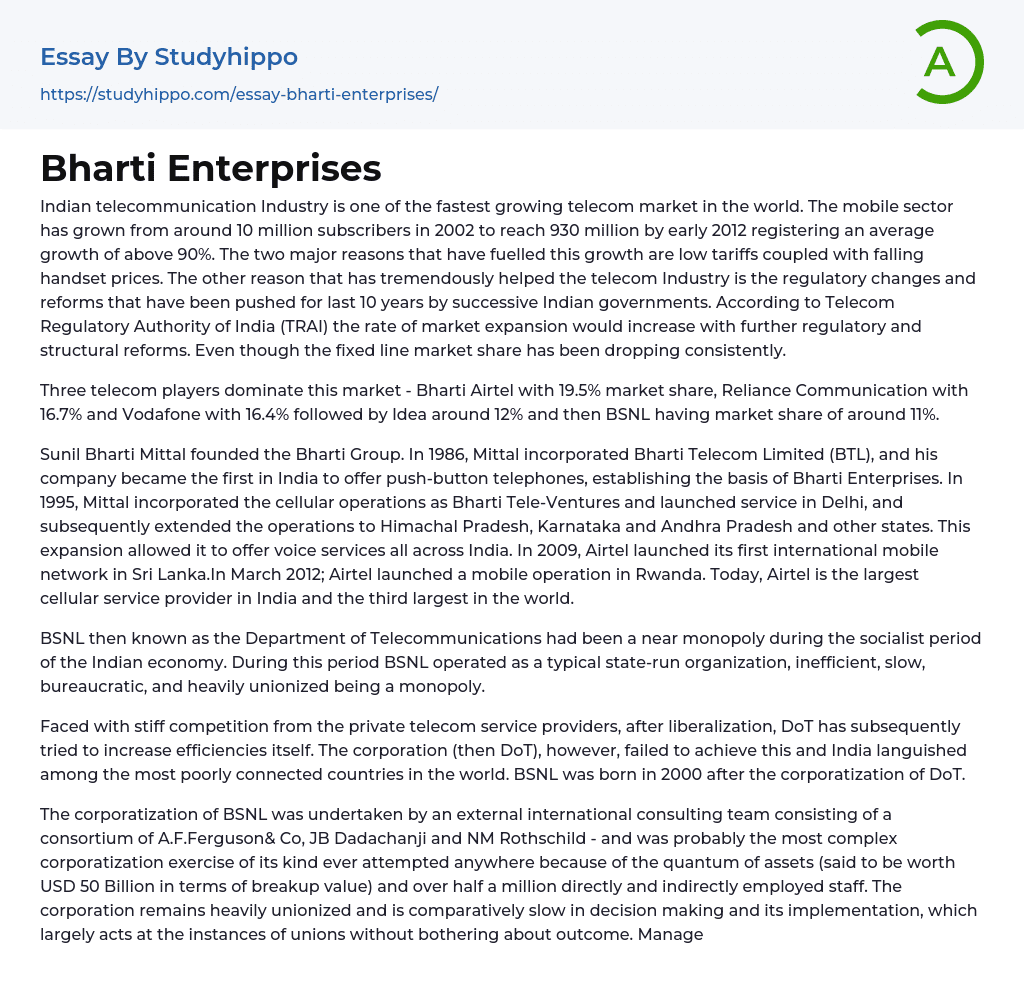The telecom industry in India is undergoing rapid growth and is one of the fastest-growing markets globally. From 2002 to early 2012, the number of mobile subscribers surged from 10 million to 930 million, indicating an impressive average growth rate of over 90%. This remarkable progress can be attributed to affordable tariffs and decreasing prices of mobile handsets. The regulatory changes and reforms implemented by successive Indian governments over the past decade have also contributed to the success of the telecom industry. The Telecom Regulatory Authority of India (TRAI) anticipates that market expansion will continue to accelerate through additional regulatory and structural reforms. However, there has been a consistent decline in the market share for fixed-line services.
Three major telecom companies dominate the market. Bharti Airtel owns 19.5% of the market share, Reliance Communication owns 16.7%, and Vodafone owns 16.4%
.... Idea follows with around 12% market share, while BSNL holds approximately 11%.
Sunil Bharti Mittal established the Bharti Group in 1986, founding Bharti Telecom Limited (BTL). BTL was India's first company to offer push-button telephones, marking the beginning of Bharti Enterprises. In 1995, Mittal created Bharti Tele-Ventures, focusing on cellular operations and initially launching services in Delhi. The company later expanded to other states like Himachal Pradesh, Karnataka, and Andhra Pradesh to provide nationwide voice services. In 2009, Airtel (a subsidiary of Bharti) introduced its international mobile network in Sri Lanka and launched a mobile operation in Rwanda in March 2012. Currently, Airtel is not only India's largest cellular service provider but also ranks as the third largest globally.
BSNL, formerly known as the Department of Telecommunications, had almost complete control and dominance during the socialist era of
the Indian economy. It functioned like a typical state-run organization with inefficiency, slow progress, bureaucratic processes, and significant union influence due to its monopoly position.
Despite the challenges brought by private telecom service providers after liberalization, the Department of Telecommunications (DoT) strived to enhance its efficiencies. Unfortunately, DoT's efforts fell short, leading India to have one of the poorest connectivity in the globe. In 2000, BSNL was formed as a result of DoT's corporatization.
The corporatization of BSNL was carried out by an external international consulting team made up of a consortium consisting of A.F.Ferguson & Co, JB Dadachanji, and NM Rothschild. This was considered the most intricate corporatization process of its kind ever attempted, due to the significant value of assets (estimated at USD 50 Billion) and the large workforce of over half a million employees, both directly and indirectly. The corporation remains highly unionized and tends to make decisions slowly, often influenced by the unions without considering the outcomes. The management has mostly reacted to the strategies employed by private telecom companies.
- Money essays
- Financial Accounting essays
- Market Segmentation essays
- Supply And Demand essays
- Purchasing essays
- Forecasting essays
- Legacy essays
- Bank essays
- Corporate Finance essays
- Financial News essays
- Financial Ratios essays
- Financial Services essays
- Free Market essays
- Shareholder essays
- Personal finance essays
- Equity essays
- Financial Crisis essays
- Banking essays
- Credit Card essays
- Currency essays
- Debt essays
- Gold essays
- Loan essays
- Enron Scandal essays
- Foreign Exchange Market essays
- Investment essays
- Venture Capital essays
- Stock Market essays
- Retirement essays
- Donation essays
- Net Present Value essays
- Income Statement essays
- Commercial Bank essays
- Debit Card essays
- Deposit Account essays
- Subprime Lending essays
- Perfect Competition essays
- Underwriting essays
- Synergy essays
- Valuation essays
- Investing essays
- Asset essays
- Depreciation essays
- Discounted Cash Flow essays
- Foreign Direct Investment essays
- Funds essays
- Internal Rate Of Return essays
- Revenue essays
- Day Trading essays
- Futures Trading essays




